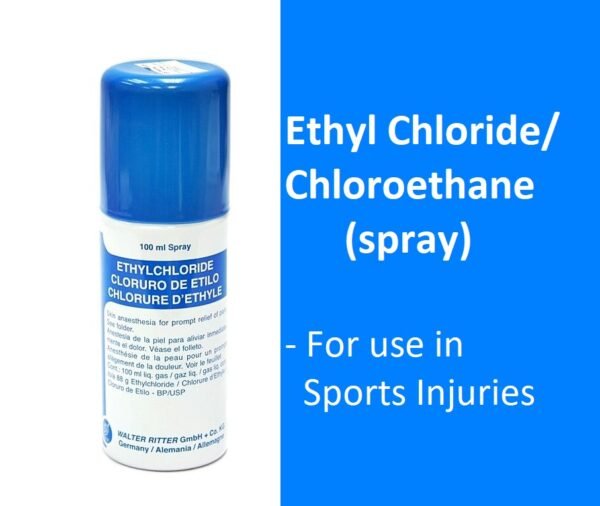Ethyl Chloride (Chloroethane) is used as a topical spray in minor sports injuries. It acts as a topical anesthetic (relieves pain) and muscle spasms instantly.
Ethyl chloride Uses:
-
Topical anesthetic:
- It is used as a topical anesthetic to relieve pain and spasms associated with minor sports injuries.
- It is also used to manage muscle strain, restricted motion, and myofascial pain.
- It may be used prior to an intravenous line placement, injection, venipuncture, a minor surgical procedure such as draining an abscess, and lancing boils.
Ethyl Chloride (Chloroethane) Dose in Adults
Ethyl Chloride (Chloroethane) Use as a topical anesthetic:
-
Minor surgical procedures and pre-injection anesthesia:
- It is sprayed over the affected area for 3 to 7 seconds (amber bottle) or for 4 to 10 seconds (aerosol).
- The medicine is sprayed from a distance of 3 - 9 inches and until the skin just turns white.
-
Myofascial pain (spray and stretch technique):
- It is sprayed over the affected area in parallel sweeps of 0.5 to 1 inch apart at a rate of four inches (10 cm/seconds) at a distance of 12 to 18 inches while the muscle is stretched passively.
- The number of sweeps is determined by the size of the muscles.
-
Relief of minor sports injuries:
- Use the smallest effective dose. The dose varies with the duration of the application.
- It is sprayed over the affected area for 3 to 7 seconds (amber bottle) or for 4 to 10 seconds (aerosol).
- The medicine is sprayed from a distance of 3 - 9 inches and until the skin just turns white.
Use in Children:
Refer to adults dosing.
Use in pregnancy and lactation:
- The drug may get absorbed from the skin. However, the amount that is absorbed into the systemic circulation is not known.
Dose in Kidney Disease:
There are no dosage adjustments provided in the manufacturer's labeling.
Dose in Liver disease:
There are no dosage adjustments provided in the manufacturer's labeling.
Side effects of Ethyl Chloride (Chloroethane):
-
Dermatologic:
- Allergic skin reaction (rare)
- Dyschromia (pigment alteration due to freezing)
- Recall skin sensitization (mucous membrane)
Contraindications to Ethyl Chloride (Chloroethane):
- Allergy to ethylchloride or any other component of the formulation
Warnings and precautions
-
Systemic effects
- If the medicine is used for a prolonged period of time and covers a large area of skin, it may be absorbed.
- There have not been any cases of chronic poisoning.
- It is possible that it could cause liver damage and kidney damage, as it is a well-known toxin.
Ethyl chloride: Drug Interaction
Note: Drug Interaction Categories:
- Risk Factor C: Monitor When Using Combination
- Risk Factor D: Consider Treatment Modification
- Risk Factor X: Avoid Concomitant Use
Risk Factor C (Monitor therapy) |
|
| Methemoglobinemia Associated Agents | May enhance the adverse/toxic effect of Local Anesthetics. Specifically, the risk for methemoglobinemia may be increased. |
Monitoring Parameters:
None mentioned. Monitor the response to treatment.
How to administer Ethyl chloride?
- This product is only for topical use. Avoid spraying it on the eyes, mucosa, and oral cavity.
- Before spraying, remove the spring valve from the amber bottle dispenser.
- Invert the spray. Keep the aerosol bottle upright while spraying.
- To minimize any local reactions, such as skin frosting, it is best to avoid prolonged spraying.
- For protection, apply petrolatum to any skin that is being used for local freezing of tissues.
- Apply moist heat for between 10 and 15 minutes to myofascial pain after it has been administered.
Mechanism of action of Ethyl chloride:
It is also known as a Vapocoolant, which instantly lowers the body temperature. This causes temporary analgesic effects.
Duration:
- A few seconds to 1 minute
International Brand Names of Ethyl chloride:
- Aethylum Chloratum
- athylchlorid Sintetica
- Chloraethyl
- Chloraethyl Adroka
- Cloretilo Chemirosa
- Cryogesic
- Holsten aktiv
- Traumazol
- WariActiv
- Wariactiv
Ethyl chloride Brands Names in Pakistan:
Brands Available in Pakistan will be updated later.


 Injection for familial chylomicronemia syndrome.jpeg)

